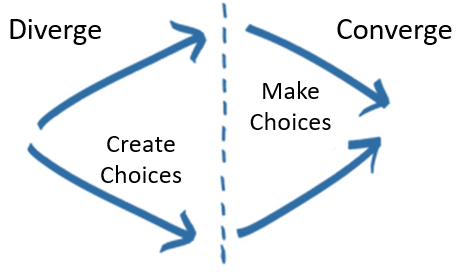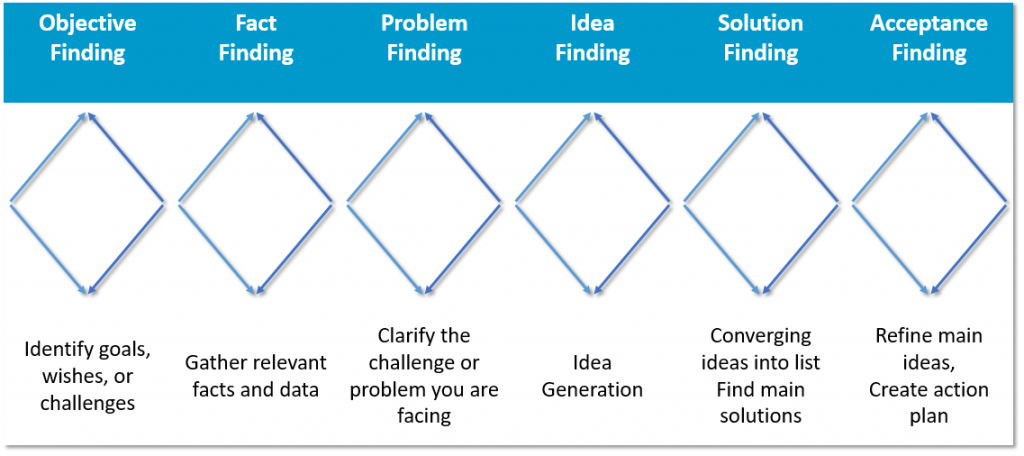Difficulty: Time:
What is Creative Problem Solving?
If you were ‘Google’-ing around for creative problem solving, you may find many which lead back to Alex Osborn, and Sid Parnes a little more than a half-century ago at Buffalo State. The many variations of this model give testament that what they achieved works.
Lets converge:
Creative: any idea that has some elements of uniqueness, at least to the one that is creating the solution, and has value which is relevant.
Problem: a challenge, opportunity, or concern.
Solving: developing ways to resolve the problem(s) at hand.
Thus, it can be considered a process or some sort of method which is systematic to approaching some sort of problem with a unique perspective to result in an effective resolution.
What is Creative Problem Solving used for?
Creative Problem Solving (CPS) can be used to develop a variety of new solutions whether its for products, services, designs or systems. Really, for anything. Use your creativity and imagination!
If at work, or actually no matter where you are or whom you’re with if you run into a problem that needs solving, you can go ahead and use this method. It can be used quickly in a small group or can take up to an hour for bigger groups.
The fundamental principle that Creative Problem Solving relies on is divergent and convergent brainstorming and thinking.
How do you use it in practice?
The model consists of six major steps: Objective, Fact, Problem, Idea, Solution, and Acceptance finding. Below you can see a visualization of the complete process and we will explain each step and provide a checklist of questions (prepared by Parnes in 1981) to improve your thinking. These are just provided as examples, they most likely will not fit the problem you are trying to solve, but use them as you wish.

Objective Finding: Here you must identify the situation or the problem. What may be the goal, or challenge which you want to work on?
- What would would you like to get out of life?
- What are your goals, as yet unfilled?
- What would you like to accomplish, to achieve?
- What would you like to have?
- What would you like to do?
- What would you like to do better?
- What would you like to happen?
- In what ways are you inefficient?
- What would would you like to organise in a better way?
- What ideas would you like to get going?
- What relationship would you like to improve?
- What would you like to get others to do?
- What takes too long?
- What is wasted?
- What barriers or bottlenecks exist?
- What wdo you wish you had more time for?
- What do you wish you had more money for?
- What makes you angry, tense or anxious?
- What do you complain about?
Fact Finding: Here you should focus on all relevant facts which may affect the outcome. The best rule of thumb is to use Who, What, When, Where, Why and how questions.
- Who is or should be involved?
- What is or is not happening?
- When does this or should this happen?
- Where does or doesnt this occur?
- Why does it or doesnt it happen?
- How does it or doesn’t it occur?
Problem Finding: Here you should clarify as best as possible what the problem is, try to frame it clearly. The one thing to remember is that the way you frame the problem, the way you define it will determine the nature of solutions in the end. Many recommend to begin each statement with the IWWMW, In what ways might we…
- What is the real problem?
- What is the main objective?
- What do you really want to accomplish?
- Why do I want to do this?
Idea Finding: This is where you will engage in brainstorming for as many potential solutions as possible. Use as many idea-generation methods you want, ideas should be proposed no matter how crazy they seem. Sometimes, the ideas that seem the craziest will be the most innovative, or help in generating more unique ideas later.
Solution Finding: Now converge on the ideas that you have just generated. You can follow the following steps:
First: create and agree on criteria to evaluate the list:
- Will it work?
- Is it legal?
- Is it possible, resource wise?
- Are the costs reasonable?
- Will it be accepted publicly?
- Will it be accepted by the higher-level administration?
Second: evaluate the list of ideas you created
Third: select up to three of the best ideas
Acceptance Finding: This is where you go back to your selected ideas, and refine them. Create an action plan for them with steps and a timetable of implementation.
Tips and Tricks (What to do and don’t do)
Divergent Thinking Guidelines
- Defer Judgment
- Strive for quantity
- Seek wild and unusual
- Build on other ideas
Convergent Thinking Guidelines
- Be affirmative
- Be deliberate
- Check the objectives
- Improve ideas
- Consider novelty
Don’t limit yourself, be creative. Get excited, your blood running. Its important when brainstorming through some of the steps to just blurt out the first things that come to mind.
Example at a real use case
Below we have provided an example how you could use Porters Five Forces to develop potential strategic directions to focus on.







